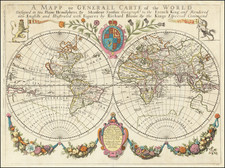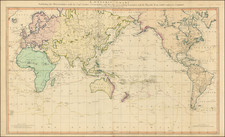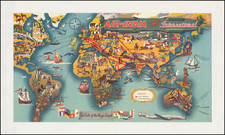An Early German Facsimile of Reisch's Modern World Map.
Attractive 1926 facsimile of the "Reisch" (but probably Oronce Fine) world map.
The simplest "tell" on this map distinguishing it from the original is the broken letter "e" in "Regnum Tharse" below the map, although a number of other features reveal the forgery to the trained eye.
Our recent research has revealed that the Reisch map, supposedly from 1513, is actually more likely from 1535. The 1513 attribution has persisted in the literature, stemming from a mis-transcribed date by Alexander von Humboldt and the confounding of this map with the modern world map published in Waldseemuller's 1513 atlas. This is outlined further below, and further suggests that this map, often attributed to Reisch, should instead be attributed to Oronce Fine.
This facsimile is recorded from quite early on. In 1939, Dr. Robert Ritter Von Srbik mentions the map in his lengthy book on the Margarita Philosophica:
Recently, the Munich publisher L. Rosenthal released three facsimile prints of the Reisch maps, which Kretschmer (1926, 161) briefly reported on.
It is unclear whether Srbik states that Rosenthal produced three copies of this facsimile or three types of facsimiles. Rosenthal produced several facsimiles of the rare early maps which he sold, including the Rüst map that is now at the Morgan Library.
The Reisch Map: 1513 or 1535?
Shirley and Bagrow (History of Cartography, page 110) both date the map to 1513, stating that it appeared in this edition of the Margarita. While Shirley notes that he was unable to find a 1513 edition of the book that had the map and that it only appeared in editions with a date of 1535, he neglects to consider the possibility that the map does not date from 1513.
We believe this date to be wrong for a number of reasons. Firstly, Shirley states that
"In its title and format the map is dearly the forerunner of that listed under Gregor Reisch (4) which was printed from a new block in 1515 and is described under that the reduced size map is a forerunner to the 1515 edition of the map."
However, the opposite seems to be true. The reduced map possesses no information not present on the enlarged map, and is a pure simplification of that 1515 map. Further, the title on the 1515 map seems to clearly be a work in progress, with insertions of omitted letters and uneven spacing - a clear contrast to the neat, and orthographically correct title on the reduced map. Both of these factors clearly suggest that the 1515 map is the earlier of the two.
The argument is furthered by the fact that there does not even seem to exist a 1513 edition of the Margarita. The purported existence of a 1513 edition of the book seems to stem from a mistranscription by Alexander von Humboldt, as concluded by several authors including Dr. Robert Ritter von Srbik in 1939. He states that:
Dr. Robert Ritter von Srbik:
A. v. Humboldt (I, 73) bemerkte hiezu (Anmerkungen von mir): Ich habe mich bemüht, durch eine Stelle, die sich in einer einzigen Ausgabe der Margarita philosophica (der von 1513) findet, die wichtigen Verhältnisse des Geographen von St. Die Hylacomilus (Martin Waldseemüller), der den Neuen Weltteil zuerst (1507) Amerika genannt hat,1 zu Amerigo Vespucci, zu dem König Renatus von Jerusalem, Herzog von Lothringen,2 und zu den berühmten Ausgaben des Ptolemaeus von 1513 und 1522 zu entwirren. Siehe mein Examen critique de la Geographie du Nouveau Continent et des progres de l’astronomie nautique aux 15 et 16 siecles, T. IV, p. 99— 125.“
Eine Ausgabe der Margarita von 1513 gibt es nicht. Offenkundig unterlief A. von Humboldt hier ein Irrtum. Es kann sich nur um die folgende Ausgabe handeln.
In translation:
A. v. Humboldt (I, 73) noted about this (with my annotations): "I have tried, through a passage found in a single edition of the Margarita philosophica (from 1513), to untangle the important relationships of the geographer from St. Die Hylacomilus (Martin Waldseemüller), who first named the New World part 'America' in 1507,1 to Amerigo Vespucci, to King Renatus of Jerusalem, Duke of Lorraine,2 and to the famous editions of Ptolemy from 1513 and 1522. See my Examen critique de la Geographie du Nouveau Continent et des progres de l’astronomie nautique aux 15 et 16 siecles, T. IV, p. 99—125."*
There is no edition of Margarita from 1513. Clearly, A. von Humboldt made a mistake here. It can only refer to the following edition.
No researcher since has been able to locate a 1513 edition of the text, and it is clear that Humboldt must have been referring to the 1515 edition.
However, this does not address how the present map came to be associated with the 1513 phantom edition. It seems that this stems from a comparison drawn by Nordenskold between the 1515 map and the modern world map in Waldsemuller's 1513 atlas, in which he states that the map is a rude copy. As later authors argued that the reduced map must predate the enlarged 1515 map and if both maps were based on the Waldseemuller atlas map, the only eligible edition that was published between 1513 and 1515 was the 1513 edition. Alternatively,
However, describing either map as a copy of the atlas map is incorrect. Rather, both maps bear a much stronger resemblance to the 1516 Carta Marina. This is true in terms of toponyms, borders, and most recognizably, in the shape of the American continent, in which North America is clearly visible. Thus, it is more likely that the 1515 map was prepared alongside or before the Carta Marina, which came out the following year.
This dating is consistent with the watermark seen on this map. This complicated watermark is characterized by a T under a horn with a three-pronged cover. Bernstein records this watermark (DE5040-PO-33161) in paper used in 1535 and 1536, confirming that this example came from 1535.









![[Second World War-era Japanese Pencil Sharpener Map of the World]](https://storage.googleapis.com/raremaps/img/small/84609.jpg)



![[Manuscript World Map] Weltkarte oder Europa, Asia . . .](https://storage.googleapis.com/raremaps/img/small/68619.jpg)
![Western Hemisphere | Eastern Hemisphere [2 sheets]](https://storage.googleapis.com/raremaps/img/small/85676.jpg)